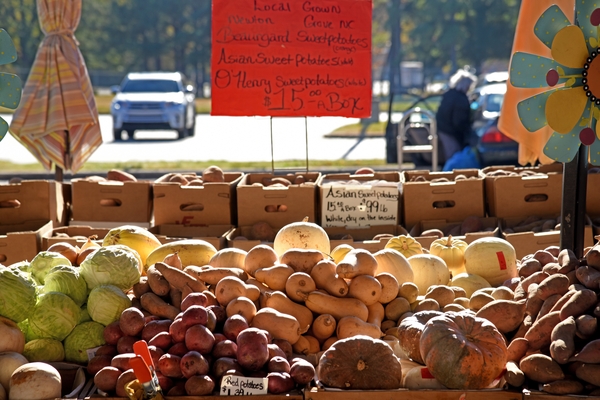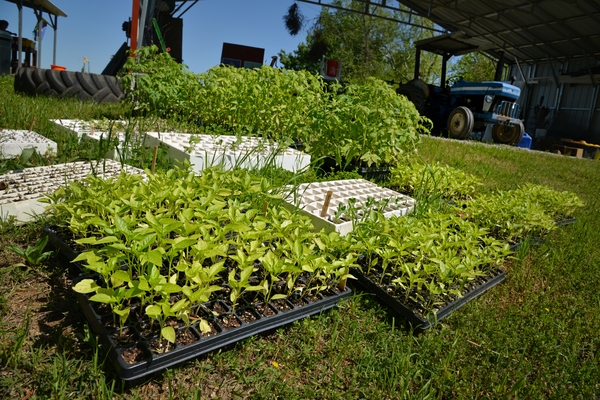Overview of Local Food Trends: Recommendations for Communication and Marketing
Dr. Katie Sanders, Assistant Professor and Extension Specialist of Food Systems Communication
Madison Lawson, Graduate Research and Extension Assistant
Local food systems have continued to grow over the past decade, driven by factors such as consumer interest, supportive politics, and producer supply (Jung et al., 2022). This makes it a good time for Extension to focus on communicating about and supporting marketing efforts for local food consumption in their communities. The following fact sheet outlines emerging demographic trends, values motivating consumer purchasing, and recommendations for those who will be communicating about and marketing local food.
Key Marketing Strategies
This fact sheet uses two communication concepts to guide recommendations for marketing, communication, and messaging strategies: framing and audience segmentation.
-
Framing - how people structure and create the way they think about an issue (Chong & Druckman, 2007, p. 104). By using frames, communicators can highlight one or more aspects of a product, service, or issue that is most important to their target audience.
-
Audience segmentation - the process of tailoring a message to a small set of a population based on their demographics, beliefs, attitudes, and psycho-social characteristics (Slater, 1996). These groupings should have shared characteristics that may serve as the basis for creating effective message frames. Demographic segmentation is one of the most popular versions of this practice. Consumers are grouped by their gender, income, age, or education (Porch Group Media, 2023). Audience segmentation is helpful in identifying which frames to use to reach your intended audience. An example of this is specifically designing the advertisement campaign for your athletic wear for the clientele you are trying to reach: middle to upper income women in their thirties and forties (Porch Group Media, 2023).
Demographic Trends in Local Food
Members of the Silent Generation (people born between the mid-1920s and 1940s) may have lower engagement with local food purchasing relative to other generations (Eiseman & Won, 2023; Kumar & Smith, 2018; Tidwell & Lamm, 2020). Consumers between the age of 30 and 44 may have the most positive attitude toward local food (Eiseman & Won, 2023). However, this can vary depending on income. Studies have demonstrated that older generation individuals with higher socioeconomic status have a favorable attitude toward local food, indicating that socio-economic status may have had more effect than generation (Feldmann & Hamm, 2015; Kumar & Smith, 2018). Across all generations, convenience and functionality seem to be highly correlated with local food purchasing intentions, especially when combined with pre-existing purchasing habits, like shopping at a grocery store (Kumar & Smith, 2018; Shin et al., 2021; Tidwell & Lamm, 2020). Some studies have demonstrated that women may be more likely to purchase local foods (Eiseman & Won, 2023; Feldmann & Hamm, 2015), while men may have a higher willingness-to-pay for local food (Feldmann & Hamm, 2015). Across generations, consumers demonstrate a high willingness-to-pay for local products; however, intention may not always directly translate into behavior, as some consumers overestimate their willingness-to-pay (Feldmann & Hamm, 2015).
Values-Based Messaging Opportunities
Consumer values are important in marketing strategies. Consumers’ social and environmental values impact local food purchasing trends, specifically related to the local community (Eiseman & Won, 2023; Holt et al., 2018; Kol et al., 2023). Concern about the local environment is connected to the intention of purchasing local food (Kumar & Smith, 2018). Additionally, concern over health and the local economy are also connected to local food purchasing intentions (Feldmann & Hamm, 2015; Kumar & Smith, 2018). Health is consistently cited as an effective frame for local food messaging (Gorham et al., 2015).
Research conducted by Torres (2020) found that 60% of college students–both Millennials and Generation Z–highly valued local food when asked to rate its importance. However, younger generations may be less motivated by social values compared to other factors, like functionality (how useful and practical products are within consumers’ daily lives; Shin et al., 2021). When social values are connected to a sense of place, local food purchasing intentions increase (Shin et al., 2021). Thus, highlighting a connection to place could enhance younger generations’ intention to purchase local foods. Place attachment also enhances older generations’ intention to purchase local food, especially in rural areas, as it may echo their desire to connect to their roots and build a sense of nostalgia for their home (Feldmann & Hamm, 2015). Familiarity with the producer may also have a positive impact on local food purchasing intention (Eiseman & Won, 2023). Two current local food initiatives in North Carolina–the Visit NC Farms App and the Appalachian Grown label–have had great success by following the strategies of place connection and familiarity.
Other predictors for engaging in local food relate to the experiential aspect of food consumption. Younger generations are often motivated to seek new food experiences, both related to geography or flavor, in search of new “novelty” experiences. These new experiences may take the form of immersive, themed restaurants, pop-up events, or simply experimenting with food from other cultures (Senior, 2023). Novelty food seekers may be more likely to purchase local food and make food purchasing decisions based on health, environmental, and social concerns as they pay close attention to food labels (Kumar & Smith, 2018). This indicates that younger generations are values-motivated; however, further research has found that Millennials and Generation Z are likely to highly prioritize convenience in shopping and meal planning over other factors. Combining convenience with new food experiences may increase their likelihood of purchasing local foods (Kumar & Smith, 2018). Availability and convenience remain two of the most consistent barriers to purchasing local food, followed closely by time (Eiseman & Won, 2023), making this a key factor influencing food purchasing decisions within these generations. Mariola et al. (2022) found that successful farmers markets often have a few larger producers offering a large quantity of a few products for convenience, such as commonly purchased fruits and vegetables, accompanied by many small producers providing diverse products to give consumers a taste of new experiences, but in smaller quantities. Thus, successful local food marketing that combines experience with convenience may be a more successful model for facilitating local food purchasing. However, Mariola et al. (2022) caution that local food demand is cyclical and seasonally dependent, limiting the success of this model across the calendar year.
Recommendations for Marketing and Communication
Effective frames for local food messaging could include highlighting the benefits of local food on health, the environment, and the local community (Kumar & Smith, 2018). Related to health, emphasizing the relationship between health and the freshness and seasonality of local food might be an effective marketing strategy. However, Gorham et al. (2015) caution that seasonality alone may not be an effective frame, further emphasizing the need for extension to utilize a combination of the ways of thinking discussed in this publication to create local food marketing strategies. Mariola et al. (2022) suggest that focusing on the values of novelty and new experiences will appeal to the younger generations–Millennials and Gen Z–who may not often be swayed by other values-based frames, such as social impacts. Marketers might also highlight specific impacts of local food on the environment by visualizing the route from farm to plate (Gorham et al., 2015). Finally, from an economic and community perspective, describing how money spent on local food is reinvested into the community may also increase purchasing intentions around local food (Kumar & Smith, 2018).
References
Chong, D., & Druckman, J. N. (2007). Framing theory. Annual Review of Political Science, 10(1), 103–126. https://doi.org/10.1146/annurev.polisci.10.072805.103054
Eiseman, D., & Won, A. S. (2023). Community attitudes toward local foods and producers: The role of warmth versus competence across demographics for social media engagement. Journal of Applied Communications, 107(1).
Feldmann, C., & Hamm, U. (2015). Consumers’ perceptions and preferences for local food: A review. Food Quality and Preference, 40, 152–164.
Gorham, L., Rumble, J., & Holt, J. (2015). The impact of local: Exploring availability and location on food buying decisions. Journal of Applied Communications, 99(2).
Holt, J., Rumble, J., Telg, R., & Lamm, A. (2018). Understanding consumer intent to buy local food: Adding consumer past experience and moral obligation toward buying local blueberries in Florida Within the Theory of Planned Behavior. Journal of Applied Communications, 102(2).
Jung, J., Tao, J., & Widmar, N. O. (2022). Quantifying “local food” online and social media in the United States for 2018–2021. Agriculture & Food Security, 11(1), 59.
Kol, O., Zimand-Sheiner, D., & Levy, S. (2023). A (local) apple a day: Pandemic-induced changes in local food buying, a generational cohort perspective. European Journal of International Management, 19(1), 1–26.
Kumar, A., & Smith, S. (2018). Understanding local food consumers: Theory of Planned Behavior and segmentation approach. Journal of Food Products Marketing, 24(2), 196–215.
Mariola, M. J., Schwieterman, A., & Desonier-Lewis, G. (2022). What do local foods consumers want? Lessonsfrom ten years at a local foods market. Journal of Agriculture, Food Systems, and Community Development, 11(3), 211–227.
Porch Group Media. (2023, October 3). 12 audience segmentation examples and how to use them.
Senior, K. (2023). The experiential dining trend which is taking the world by storm. Flavour Blaster.
Shin, Y. H., Kim, H., & Severt, K. (2021). Predicting college students’ intention to purchase local food using the theory of consumption values. Journal of Foodservice Business Research, 24(3), 286–309.
Slater, M. (1996). Theory and method in health audience segmentation. Journal of Health Communication, 1(3), 267–284.
Tidwell, A., & Lamm, A. (2020). Identifying levels of engagement in local food systems by generation in the State of Georgia, U.S.A. Journal of Applied Communications, 104(1).
Torres, A. P. (2020). Research report: For young Americans, sustainable is not organic. Journal of Food Distribution Research, 51(1), 71-77.
Publication date: May 20, 2024
Reviewed/Revised: July 25, 2024
N.C. Cooperative Extension prohibits discrimination and harassment regardless of age, color, disability, family and marital status, gender identity, national origin, political beliefs, race, religion, sex (including pregnancy), sexual orientation and veteran status.



